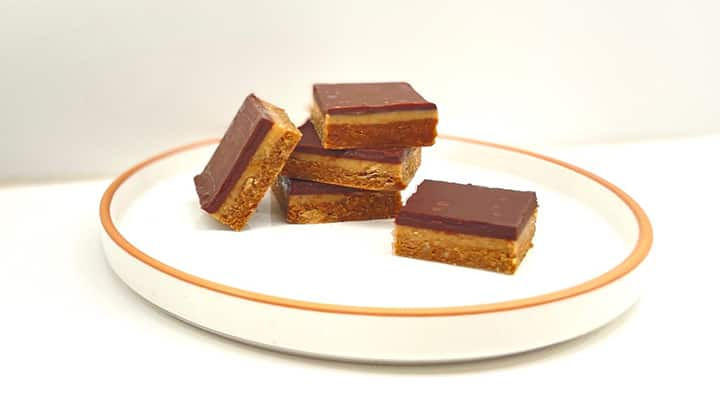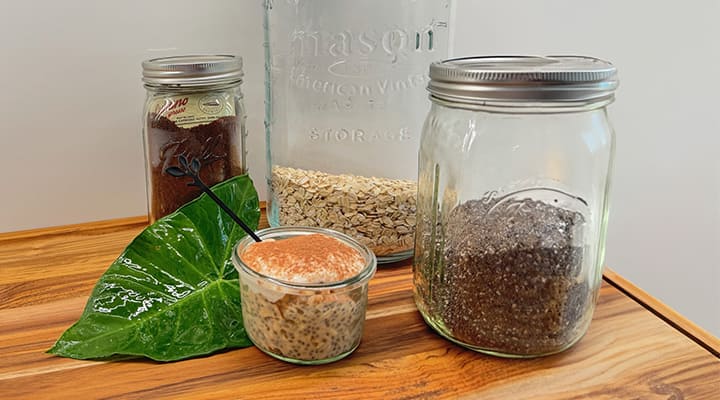
Roasted Vegetable Recipe with Avocado Salad Dressing
Published: February 2022
Want to show yourself a little love? This roasted vegetable salad is bursting with flavor and packed full of nutrients such as magnesium that support your heart.
Heart Healthy Roasted Vegetable Salad
Eating healthy is easy—at least in this case. These seasonal vegetables are simply tossed with olive oil, seasoned and oven-roasted. The healthy avocado and citrus dressing comes together in minutes. Chickpeas and pumpkin seeds add plant-based protein and heart-healthy fat to make this a perfect meal to celebrate cardiovascular health during American Heart Health month.
The best vegetables to roast
The best roasted vegetables are starchy and hardy vegetables like potatoes and squashes. The oven browns them and gives them a soft center, which elevates their flavors. Cruciferous vegetables like broccoli and cauliflower are also delicious roasted. The oven makes them crispy on the edges and not mushy in the middle. Plus, cruciferous vegetables are breast health superstars!
Looking for something else? Any vegetable works in the oven if you adjust cooking time and chop size.
How to roast vegetables
Roasting vegetables is easy! All you need is a sheet pan, a heart-healthy cooking oil and about 30 minutes of time. And these humble salad ingredients are easy to find year-round in most markets.
The ingredient list includes:

- Yam or sweet potato
- Butternut squash
- Cauliflower
- Broccoli
- Zucchini or yellow squash
- Baby bell peppers
- Chickpeas
- Raw pumpkin seeds
- Arugula or baby spinach
- Orange juice
- Lemon juice
- Olive oil
- Avocados
- Cilantro
- Salt and pepper
Can I add nuts and seeds to my roasted vegetable salad?
Adding nuts and seeds to a salad is always a great idea. They add protein and healthy fat, which is wonderful for heart health. I use pumpkin seeds because they are a great source of magnesium. But walnuts are also a great addition because they are rich in alpha-linoleic acid, the vegan-friendly omega-3. Both are good for helping you look and feel your best!
What's the best oil for my roasted vegetable salad?
As a chef, I have always favored olive oil for both cooked and raw presentations. I simply enjoy the flavor. Olive oil has a lower smoking point than other oils, but I find that when roasting at 400 degrees, it works perfectly. Avocado oil is my second choice when it comes to cooking, mostly because of the price point. Typically, a good avocado oil is more expensive than a good olive oil. Plus, avocado oil does not have the flavor profile that I enjoy.
Recipe: Roasted Vegetables with Avocado Salad Dressing

Prep: 10 minutes
Cook: 30 minutes
Cooling: 15 minutes
Serves: 4-5 people
Ingredients for dressing:
- 1/2 cup orange juice
- 1/4 cup lemon juice
- 1/4 cup California Estate Extra Virgin Olive Oil
- 2 avocados, peeled and seeded
- 1/4 bunch cilantro, washed and rough chopped
- 1 pinch salt
- Pepper to taste
Ingredients for salad:
- 1 large yam, about 2 cups chopped in small pieces
- 1/2 butternut squash, chopped in cubes
- 1 head cauliflower, cut in large florets
- 1 head broccoli, cut in florets
- 1 zucchini, cut in large pieces
- 5 baby bell peppers, seeded and chopped
- 1 can chickpeas, rinsed and drained
- 4 Tbsp. raw, unsalted pumpkin seeds
- 2 Tbsp. extra virgin olive oil
- 2 pinches salt
- 2 pinches black pepper
Directions:
- Preheat oven to 400 degrees
- Chop vegetables. Yams, which are hearty and take a long time to cook, should be cubed small. Cut butternut squash in larger cubes since they cook faster. Chop cauliflower, broccoli and zucchini, which cook quicker, in larger pieces.
- On one large sheet pan, add 1 Tbsp. olive oil and spread to the edges with your hand. Add the yam, butternut squash and cauliflower and spread out in a single layer. Sprinkle with a pinch of salt and pepper and cook for 30 minutes. Check for doneness and add 5 minutes if necessary. Set aside to cool.
- On another sheet pan, add 1 Tbsp. olive oil and spread to the edges with your hand. Add the broccoli, baby bell peppers, zucchini and chickpeas and spread in a single layer. Season with a pinch of salt and pepper. Cook for 20 minutes. Set aside to cool.
- Make the dressing with a high-speed blender or food processor. Add ripe avocado, orange juice, lemon juice, olive oil, cilantro, salt and pepper. Blend until smooth.
- Once cooled, add vegetables to a large bowl or platter over a bed of arugula or spinach. Sprinkle with nuts or seeds. Drizzle dressing if serving immediately or keep separate until serving.
Explore Our Best Food & Drink Formulas
How to make the perfect roasted vegetables
For perfect roasted vegetables, the rule of thumb is to cook at 400 degrees for 20-30 minutes. Use scant oil for a delicious brown char and always preheat the oven.
Cut starchy or hardy vegetables small because they can take a long time to cook if left in large pieces. Chop vegetables like zucchini—which cook quickly—in large pieces. By cutting vegetables this way, you can safely roast different vegetables on the same sheet pan.
How to make healthy avocado dressing
The combination of citrus and ripe avocado makes a healthy and delicious salad dressing. I love the bright pop of fresh flavor from cilantro, but any herb will do. Basil and dill are great substitutes. This dressing is rich and creamy and feels decadent, yet is very good for you and packed with healthy vitamins and minerals.
What are the health benefits of avocados?
Avocados are fruits—berries to be exact. Everyone knows avocados are good for you, but why?

- They are rich in fiber, vitamins C and K, and minerals like potassium, magnesium, and folate. According to the American Heart Association, research suggests that avocado consumption is associated with heart health.
- They are high in heart-healthy fat and contain a compound called beta-sitosterol, both of which help maintain already-healthy cholesterol levels.
- They help the body better absorb nutrients from food. So pairing avocado with tomatoes or carrots, for instance, can help you get more vitamin A from your meal.
What's in an avocado?
Here is the nutrition breakdown for a 7-ounce (201-gram) avocado, from the U.S. Department of Agriculture:
- Calories: 322
- Fat: 30 grams
- Protein: 4 grams
- Carbs: 17 grams
- Fiber: 14 grams
Avocados are also a good source for other vital nutrients:

- Vitamin C: 22% of the daily value (DV)
- Vitamin E: 28% of the DV
- Vitamin K: 35% of the DV
- Riboflavin (B2): 20% of the DV
- Niacin (B3): 22% of the DV
- Pantothenic acid (B5): 56% of the DV
- Pyridoxine (B6): 30% of the DV
- Folate: 41% of the DV
- Magnesium: 14% of the DV
- Potassium: 21% of the DV
- Copper: 42% of the DV
- Manganese: 12% of the DV
Can you get enough healthy fats from avocados?
Avocados are a good source of omega-3. But like most plants, they have lower levels than many animal-based sources. This makes getting enough fatty acids difficult for vegans and vegetarians.
That is why supplementing a healthy diet is important. Even healthy eaters should take a plant-based multivitamin or Vegetarian DHA supplement to fill in any nutritional gaps left by their diet. I recommend Life Extension's Plant-Based Multivitamin to help you get the full range of health benefits from your vegan or vegetarian diet.
References
- Booth, Stephanie. "Avocado." WebMD, July 2020, https://www.webmd.com/food-recipes/all-about-avocados
- Dreher, Mark L. et al. "A Comprehensive Review of Hass Avocado Clinical Trials, Observational Studies, and Biological Mechanisms." Nutrients, December 2021, https://www.mdpi.com/2072-6643/13/12/4376
- Fulgoni III, Victor et al. "Avocado consumption is associated with better diet quality and nutrient intake, and lower metabolic syndrome risk in US adults: results from the National Health and Nutrition Examination Survey (NHANES) 2001–2008." Nutrition Journal, January 2013, https://nutritionj.biomedcentral.com/articles/10.1186/1475-2891-12-1
- Ioffee, Karina. "Avocados are a healthy option Super Bowl Sunday – and year-round." American Heart Association News, February 2021, https://www.heart.org/en/news/2021/02/05/avocados-are-a-healthy-option-super-bowl-sunday-and-year-round
- Kopec, Rachel et al. "Avocado Consumption Enhances Human Postprandial Provitamin A Absorption and Conversion from a Novel High–β-Carotene Tomato Sauce and from Carrots." The Journal of Nutrition, August 2014, https://doi.org/10.3945/jn.113.187674
- Kubala, Jillian. "7 Potential Health Benefits of Avocado." Healthline Nutrition. November 2021.
- "Avocados." USDA FoodData Central, https://fdc.nal.usda.gov/fdc-app.html#/food-details/171705/nutrients
- "Magnesium Rich Food." Cleveland Clinic, November 2020, https://my.clevelandclinic.org/health/articles/15650-magnesium-rich-food
- Dreher, Mark, et. al. "A Comprehensive Review of Hass Avocado Clinical Trials, Observational Studies, and Biological Mechanisms." Nutrients. 2021, https://www.mdpi.com/2072-6643/13/12/4376
Always be in the know!
Access the latest deals, wellness news, expert health tips & more!





